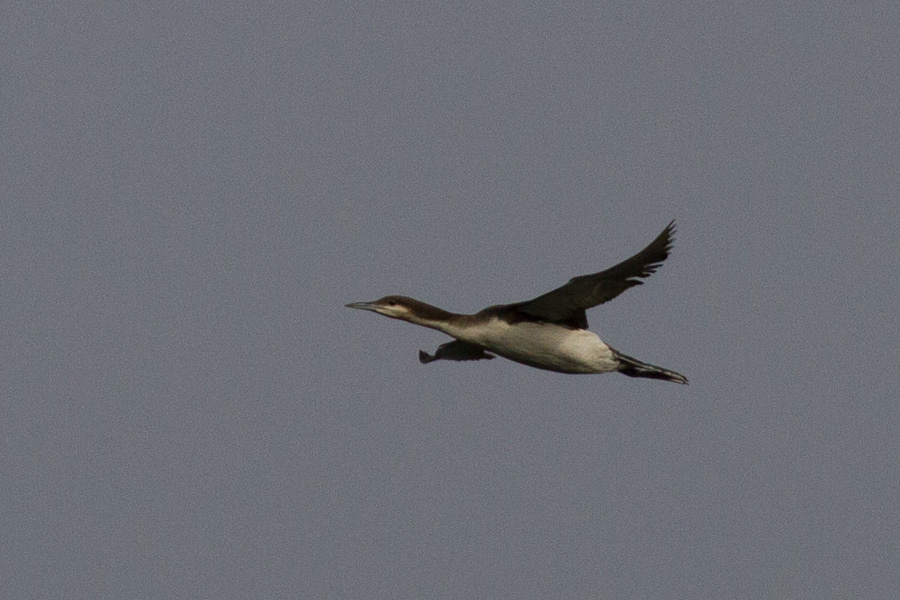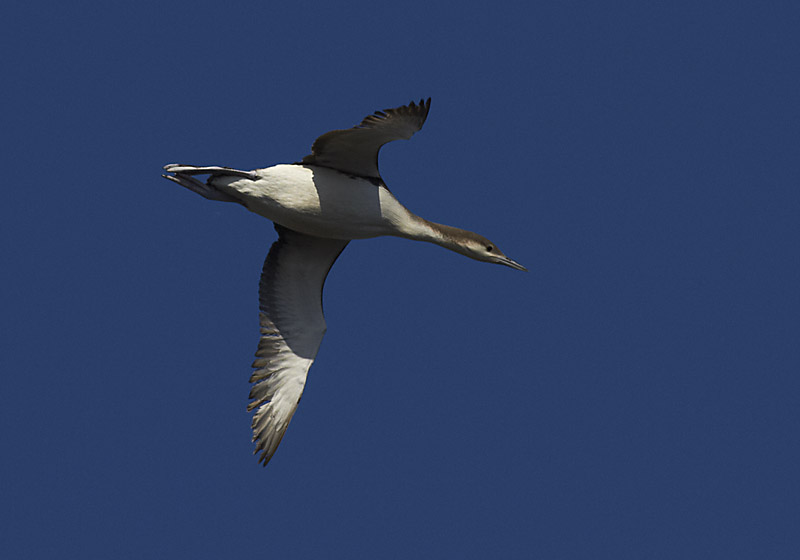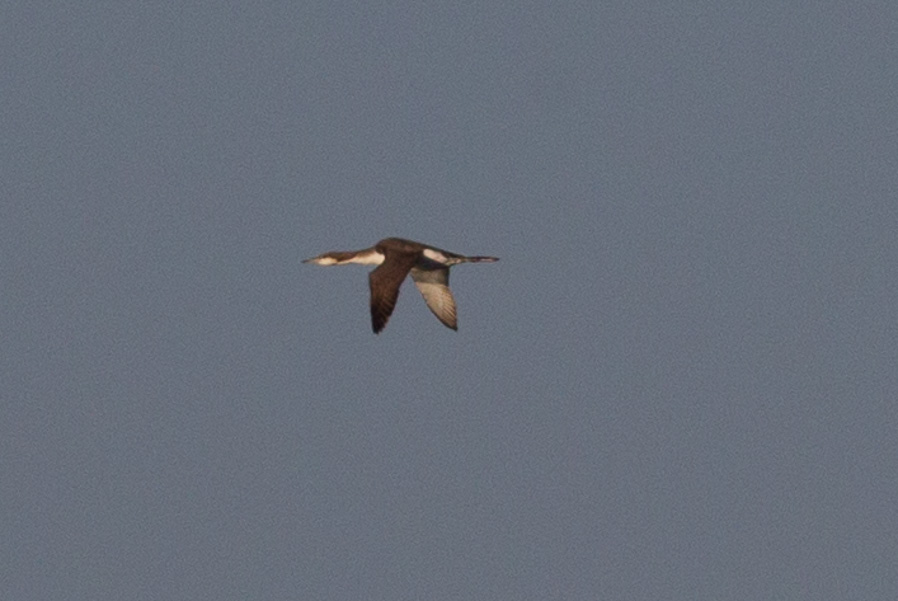Kuikan iänmäärityksestä keväällä
Ageing Black-throated Divers in spring
-
Suomi
-
English
Kuikan pukuvaihtelu on varsin toisenlainen kuin kaakkurin. Kevätmuutolla ne on helppo jakaa kahteen luokkaan, erityisesti toukokuussa, kun päämuutto Suomenlahdella tapahtuu. Pääosa linnuista näyttää juhlapukuisilta ja vähemmistö talvipukuisilta. Vaihtelua on, mutta ei mitenkään valtavasti.
The plumage variation of Black-throated Diver is different from that of Red-throated. During spring migration, Black-throateds are easy to separate into two classes - especially during May, when most of the migration occurs in the Gulf of Finland. Most of the birds are in adult summer plumage, and a minority shows what looks like a winter plumage aspect.
Nämä havainnot sopivat hyvin yhteen sen kanssa, mitä Jonsson & Tysse 1992, Lommar, kirjoittavat. He mainitsevat mm. että kuikat tulevat kolmannen kalenterivuoden keväällä mahdottomiksi erottaa aikuisista linnuista ja että kaikki talvipukuisen näköiset linnut touko-elokuussa ovat 2kv yksilöitä. Pyle 2008, Identification Guide to North American Birds, kertoo kuitenkin, että 3kv kevätlinnut olisivat vaihtelevan välimuotoisia - kaulan juovat olisivat epäselvempiä kuin aikuisella ja kurkku olisi musta-valkotäpläinen. Tällaisia lintuja ei kuitenkaan Suomenlahdella keväällä näe.
These observations agree well with what is written by Jonsson & Tysse 1992, Lommar. They state that Black-throated Divers become impossible to separate from adults during the spring of their third calendar-year, and all birds with winter-type plumage aspect during May-August are second calendar-year individuals. However, Pyle 2008, Identification Guide to North American Birds, describes 3cy spring birds as variable but intermediate between 2cy and adult - with variably indistinct black and white stripes and throat variably mottled dull blackish and white. These kind of birds do not occur in the Gulf of Finland during spring.
Joitain havaintoja 2kv - lintujen yleisyydestä aktiivisesti kevätmuuttavissa linnuissa vuonna 2017: 25.5. ja 27.5.Kirkkonummen Porkkalan alueella 8,2% oli 2kv lintuja (n=195). Porvoon Söderskärillä 27.5. 8,3% oli 2kv (n= 156) ja 28.5. 14,8% (n= 61). Kesäkuulle tultaessa 2kv-lintujen osuus nousee, Helsingin Santahaminassa 7.6. se oli 62,8% (n=43).
Some percentages of 2cy in Finland, in 2007: 25. and 27 May at Kirkkonummi, Porkala 8,2% (n=195), at Porvoo, Söderskär on 27 May 8,3% (n= 156) and on 28 May 14,8% (n= 61). The ratio of 2cy becomes larger by June: at Helsinki, Santahamina on 7 June 62,8% (n=43).
Keväällä 2018 seurasimme merimuuttoa säännöllisesti ja merkitsimme ylös puvut riittävän hyvin nähdyiltä yksilöiltä. Havainnointiaika oli 1.4.-10.6. Näyttää siltä, että aikuiset kuikat ovat jo kesäpuvussa saapuessaan keväällä pohjoiselle Itämerelle. Nuoret linnut ovat talvipukuisen näköisiä ja pysyvät suunnilleen saman näköisinä koko kevään. Nuorten lintujen muutto on selvästi myöhäisempi kuin aikuisten.
During the spring of 2018 we watched seabird migration quite regularly and classified the plumage aspect of Black-throated Diver to summer-plumage and winter-plumage like. Classification is straightforward and the two classes distinct. Observation period was 1 April - 10 June. It seems that adult birds are already in summer plumage when they reach Northern Baltic in spring. Young birds have the winter plumage aspect and retain it until June at least. The migration period of young birds is distinctly later.
| Breeding | Winter | n | |
|---|---|---|---|
| April | 100% | 0% | 157 |
| 1st half of May | 98% | 2% | 423 |
| 2nd half of May | 98% | 2% | 2690 |
| June | 69% | 31% | 120 |
-
1
-
2
-
3
Kuva 1. 1.6.2012 Santahamina, Helsinki, Finland. Tällä yksilöllä on melko yhtenäisen tumma kaulan takaosa ja päälaki.
Photo 1. 1 June 2012 Santahamina, Helsinki, Finland. This bird has a rather uniform dark cap and hindneck.
Kuva 2. Söderskär, Porvoo, Suomi. 21.5.2010. Tällä yksilöllä on melko selvä tummempi pitkittäisjuova kaulan sivua pitkin ja täplityksen tapaista kaulan sivuilla ja edessäkin
Photo 2. Söderskär, Porvoo, Finland, 21 May 2010. Rather distinct dark longitudinal streaks along the neckside, and some spotting on the neck sides and even on the throat.
Kuva 3. Söderskär, Porvoo, Suomi. 24.5.2014. Kauempaa usein tumma kaulansivujuova on silmiinpistävä, kontrastoituen vaaleampaan niskaan. Pää takana kaulan yläosassa tumma ulottuu aina alaspäin ja näyttää toisinaan yltävän kaulan etuosaan asti.
Photo 3. Söderskär, Porvoo, Finland. 24 May 2014. From a distance, the dark stripe on the sides of the neck is often distinct, contrasting with the slightly paler hindneck. Invariably, the dark of the hindneck reaches downwards just behind the head and in some cases it seems to reach the foreneck.


